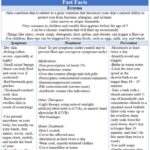What’s causing the rash?
When you were a child, you remember having itchy areas on your skin but didn’t know what it was from. As an adult, you wake up one morning and find that on one of your arms, near your elbow, you have a spot of red skin with small bumps that are incredibly itchy. What is this? What is causing it? How is it treated?
 Definition
Definition
Eczema is a skin condition related to a gene variation that decreases your skin’s natural ability to protect you from bacteria, allergens, and irritants. It’s also known as atopic dermatitis. It’s very common in children and usually first appears before the age of 5. Unfortunately, it’s a chronic condition that will flare up occasionally and then can be gone for long periods. Some things, like stress, sweat, soaps, detergents, dust, pollen, and obesity, can trigger a flare-up. Children’s flare-ups can be triggered by certain foods, such as eggs, milk, soy, and wheat.
Eczema symptoms can vary widely but usually include dry skin, itching (often severe, especially at night), small raised bumps (can leak fluid and crust over if scratched), red/brownish-gray patches, thickened/cracked/scaly skin and raw/sensitive/swollen skin (a result of scratching). While it can present anywhere on your body, it typically appears on your hands, feet, ankles, wrists, neck, upper chest, eyelids, and inside the bend of your elbows/knees. For babies, it can appear on their faces and scalp. Eczema can cause several complications, including skin infections resulting from breaks in the skin from scratching. Other problems are allergic contact dermatitis and irritant hand dermatitis (common for individuals whose hands are often wet and exposed to harsh soaps, detergents, or disinfectants—usually while at work). Some individuals also have sleep problems due to the itching. Chronic itchy, scaly skin (neurodermatitis) happens when you scratch an area causing it to become even itchier, resulting in you scratching it more and eventually, that skin becomes discolored, thick, and leathery-looking. Sometimes, eczema can precede asthma and hay fever in kids under 13.
Treatment
The goal of treating eczema is to get symptoms under control and prevent flare-ups. The key is to recognize symptoms early so treatment can be initiated as soon as possible. Using non-prescription (at least) 1% hydrocortisone cream is often helpful in decreasing the itchiness. Taking over-the-counter allergy or anti-itch medication can also be useful in reducing the amount of itching.
Several prescription medications are used to treat eczema, but the most common are corticosteroid creams or ointments that help to control itching and allow the skin to heal. For it to penetrate the skin, you should put it on after applying moisturizer. Other creams are designed to impact your immune system to decrease your body’s inflammatory response. The critical thing to remember with these creams is to avoid exposing the area to the sun. If you develop an infection from scratching, your doctor will prescribe antibiotic cream or pills. You can take corticosteroid pills to reduce inflammation, but these are usually reserved for severe cases of eczema due to the side effects they can cause.
If your eczema doesn’t go away with topical creams/ointments or comes back quickly, your doctor may recommend exposing the area to a controlled amount of natural sunlight, artificial ultraviolet A (UVA), or narrow band ultraviolet B (UVB) either in addition to medications or alone. For severe eczema, you might need to place topical corticosteroid cream on the area and then wet bandages over the top. This is often done in a hospital setting for widespread lesions. For babies, it’s essential to identify anything that irritates their skin, avoid temperature extremes and lubricate their skin using bath oils, creams or ointments.
You can do some things at home to help relieve the discomfort from eczema. The most important is to not scratch. To help you do this, cover the affected area with bandages. The next best thing is moisturizing at least twice daily. Wearing cool, smooth-textured clothes is vital to prevent irritation. Since hot, dry indoor air can increase your skin’s sensitivity, use a humidifier. Sometimes, soaking in a warm, not hot, bath that has baking soda, uncooked oatmeal, or colloidal oatmeal in it for 10 – 15 minutes can lessen the irritation. Addressing stress and anxiety is also crucial since these can trigger eczema episodes.
Prevention
There are several things you can do to prevent eczema flares. The first is the same as treating it: moisturizing at least twice a day. Next, it’s critical to identify any triggers that cause the flares to occur. Make sure the water isn’t too hot when you shower or take a bath and limit the time you spend to no longer than 10 – 15 minutes.
A recommendation by the American Academy of Dermatology is taking a bath with a bleach mixture to help decrease the number of bacteria on your skin. To create the right mix, add ½ cup of household (not concentrate) bleach to a standard-sized bathtub filled with water up to the overflow drain. Remember to only soak from the neck down and not to stay in longer than 10 minutes. Don’t do this more than twice a week. For regular bathing, use mild soaps and gently pat your skin dry when you’re finished. While your skin is still damp, apply moisturizer to trap in any extra moisture.
Eczema can be an annoying condition to deal with, but by taking all the precautions you can, you’ll be able to increase the time between flare-ups. If you have any questions or concerns, please speak with your doctor. If you would like more information, please visit the American Academy of Dermatology’s Eczema Resource Center page at https://www.aad.org/diseases/eczema